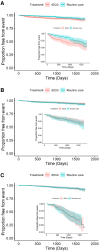Incident atrial fibrillation and adverse clinical outcomes during extended follow-up of participants recruited to the remote heart rhythm sampling using the AliveCor heart monitor to screen for atrial fibrillation: the REHEARSE-AF study
- PMID: 37205320
- PMCID: PMC10187779
- DOI: 10.1093/ehjopen/oead047
Incident atrial fibrillation and adverse clinical outcomes during extended follow-up of participants recruited to the remote heart rhythm sampling using the AliveCor heart monitor to screen for atrial fibrillation: the REHEARSE-AF study
Abstract
Aims: Atrial fibrillation (AF) is an important risk factor for stroke, which is commonly asymptomatic, particularly in older patients, and often undetected until cardiovascular events occur. Development of novel technology has helped to improve detection of AF. However, the longer-term benefit of systematic electrocardiogram (ECG) screening on cardiovascular outcomes is unclear.
Methods and results: In the original REHEARSE-AF study, patients were randomized to twice-weekly portable electrocardiogram (iECG) assessment or routine care. After discontinuing the trial portable iECG assessment, electronic health record data sources provided longer-term follow-up analysis. Cox regression was used to provide unadjusted and adjusted hazard ratios (HR) [95% confidence intervals (CI)] for clinical diagnosis, events, and anticoagulant prescriptions during the follow-up period. Over the median 4.2-year follow-up, although a greater number of patients were diagnosed with AF in the original iECG group (43 vs. 31), this was not significant (HR 1.37, 95% CI 0.86-2.19). No differences were seen in the number of strokes/systemic embolisms or deaths between the two groups (HR 0.92, 95% CI 0.54-1.54; HR 1.07, 95% CI 0.66-1.73). Findings were similar when restricted to those with CHADS-VASc ≥ 4.
Conclusion: A 1-year period of home-based, twice-weekly screening for AF increased diagnoses of AF for the screening period but did not lead to increased diagnoses of AF or a reduction in cardiovascular-related events or all-cause death over a median of 4.2 years, even in those at highest risk of AF. These results suggest that benefits of regular ECG screening over a 1-year period are not maintained after cessation of the screening protocol.
Keywords: Atrial fibrillation; Electrocardiography; Mass screening; Preventive medicine; Stroke.
© The Author(s) 2023. Published by Oxford University Press on behalf of the European Society of Cardiology.
Figures


References
-
- Chugh SS, Havmoeller R, Narayanan K, Singh D, Rienstra M, Benjamin EJ, Gillum RF, Kim YH, McAnulty JH Jr, Zheng ZJ, Forouzanfar MH, Naghavi M, Mensah GA, Ezzati M, Murray CJL. Worldwide epidemiology of atrial fibrillation: a Global Burden of Disease 2010 Study. Circulation. 2014; 129:837–847. - PMC - PubMed
-
- Risk factors for stroke and efficacy of antithrombotic therapy in atrial fibrillation. Analysis of pooled data from five randomized controlled trials. Arch Intern Med 1994;154:1449–1457. - PubMed
-
- Ruff CT, Giugliano RP, Braunwald E, Hoffman EB, Deenadayalu N, Ezekowitz MD, Camm AJ, Weitz JI, Lewis BS, Parkhomenko A, Lewis BS, Parkhomenko A, Yamashita T, Antman EM. Comparison of the efficacy and safety of new oral anticoagulants with warfarin in patients with atrial fibrillation: a meta-analysis of randomised trials. Lancet 2014;383:955–962. - PubMed
-
- Halcox JPJ, Wareham K, Cardew A, Gilmore M, Barry JP, Phillips C, Gravenor MB. Assessment of remote heart rhythm sampling using the AliveCor heart monitor to screen for atrial fibrillation: the REHEARSE-AF study. Circulation 2017;136:1784–1794. - PubMed
LinkOut - more resources
Full Text Sources

